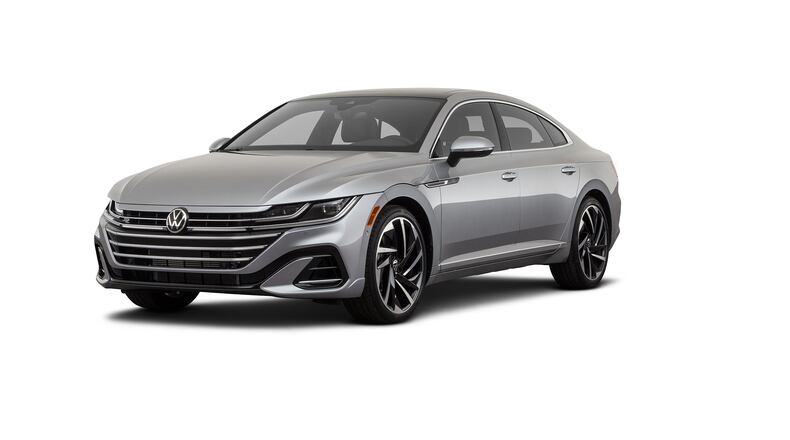The answer lies in Europe, where this sexy four-door premium hatchback has been on sale since 2017. So America benefits from Europe’s marketing needs, adding some much-needed class to the top of VW’s mass market lineup.
The 2021 Volkswagen Arteon is offered in three trims: SE, SEL R-Line, and SEL Premium R-Line, all powered by the same engine: a turbocharged 2.0-liter four-cylinder engine mated to an eight-speed automatic transmission. Front wheel-drive is standard on the SE and SEL R-Line; the latter can also be fitted with 4Motion all-wheel drive for an additional $1,800. SEL Premium R-Lines get all-wheel drive as standard equipment. SE models wear 18-inch rubber, with SEL R-Line’s getting 19 inches, and SEL Premium R-Line models shod with 20-inch wheels.
When it comes to driver assistance systems, all Arteons come well-equipped. But it’s the R-Line that nets you VW’s new Travel Assist feature, which provides partially-automated driving up to 95 mph. It also gets you Emergency Assist, which brings the vehicle to a stop if the driver is incapacitated.
But that could describe any number of Volkswagen products. What separates the Arteon from its plebian siblings is its appearance. Just gaze at it and it’s hard not to be drawn in by its sporty appearance, with Audi-like allure and crisp handsome lines. It’s far more enticing than the Passat, which was styled with the same level of passion given to a breadbox, or a crossover for that matter, which is little more than an aerodynamic breadbox.
For 2021, the Arteon gets a modestly updated front end, while the backside sees revisions as well, with the model’s named spelled out in chrome letters.
The bigger changes await inside, where Volkswagen’s interior designers opted for a cabin far better furnished than last year’s. Thankfully, they redesigned the instrument panel, the center console, and the top sections of the door panels to impart a far better ambience. New aluminum trim adorns the cabin of base SE models, while the others receive translucent lighting with a choice of 30 colors. The automatic climate controls are now touch-sensitive buttons, and the standard Arteon-specific steering wheel features touch-sensitive buttons with haptic feedback. Base models get leatherette seating surfaces with heated, 12-way power front seats. Other trims feature Nappa leather seating surfaces and driver’s seat memory settings. If you simply must have ventilated front seats, heated rear outboard seats, and a massaging function for the driver, you’ll have to opt for the SEL Premium R-Line.
When it comes to tech, an 8-inch touchscreen is standard, and comes with navigation, HD radio, SiriusXM radio, Apple CarPlay, Android Auto, VW’s App Connect smartphone integration and Bluetooth for two phones. In addition, there’s a 10-inch screen in front of the driver that can be adjusted to fill the screen with the navigation map, similar to an Audi. There are two USB-C ports, one in the center console, the other on the instrument panel. SEL Premium R-Line models add a third charge-only port in the rear console, as well as wireless charging on the center console.
The Arteon is built using Volkswagen’s corporate MQB platform, employing an independent front suspension and a four-link independent rear suspension with gas-filled dampers. Both axles are equipped with anti-roll bars and vented disc brakes.
Plop yourself into the Arteon, and you’ll find a cabin that’s positively posh compared to the usual VW fare, although some detailing remains classically VW, such as the infotainment system knobs and turn lever stalk. Seat comfort is long-term comfy, and head and leg room are impressive front and rear. In fact, given the availability of all-wheel drive, you have to wonder why someone would choose a VW compact crossover instead. It’s impressively spacious throughout, including the cargo hold.
Once up to speed, you’ll find the Arteon to be more entertaining than most automotive bread boxes. It’s a fairly quiet place, with little road or tire noise intruding into the cabin. Thanks to the suspension dampers, this premium hatch beautifully balances ride comfort and handling ability as long as the driving mode is set to sport. Put it in comfort and you’ll be treated to a lot more ride motions and rebound.
The driveline proves responsive enough, although it can hesitate before downshifting and offering up more power, a nod to fuel economy over performance. But in comparison to its chief rival, the Kia Stinger GT, it has nowhere near enough horsepower or handling chops to compete as a sports sedan. Instead, consider this a cushy grand tourer.
So even though the Arteon doesn’t seem intensely sporty, deferring in part to the comfort side of the equation, it’s an interesting alternative and a remarkably special Volkswagen. It’s a great substitute for the myriad crossovers clogging our byways, and far more beautiful to behold.
____
2021 VOLKSWAGEN SEL R-LINE
- Base price: $43,495
- Engine: Turbocharged 2.0-liter four-cylinder
- Horsepower/Torque: 268/258 pound-feet
- EPA fuel economy (city/highway): 20/31 mpg
- Observed fuel economy: 25 mpg
- Recommended fuel: Premium
- Length/Width/Height: 191.6/73.7/56.9 inches
- Payload: 904 pounds
- Cargo capacity: 27.2-56.2 cubic feet
Barry Spyker was the automotive columnist for The Miami Herald and editor of its Wheels & Waves section. Readers may send him email at spy2351@yahoo.com.
About the Author

